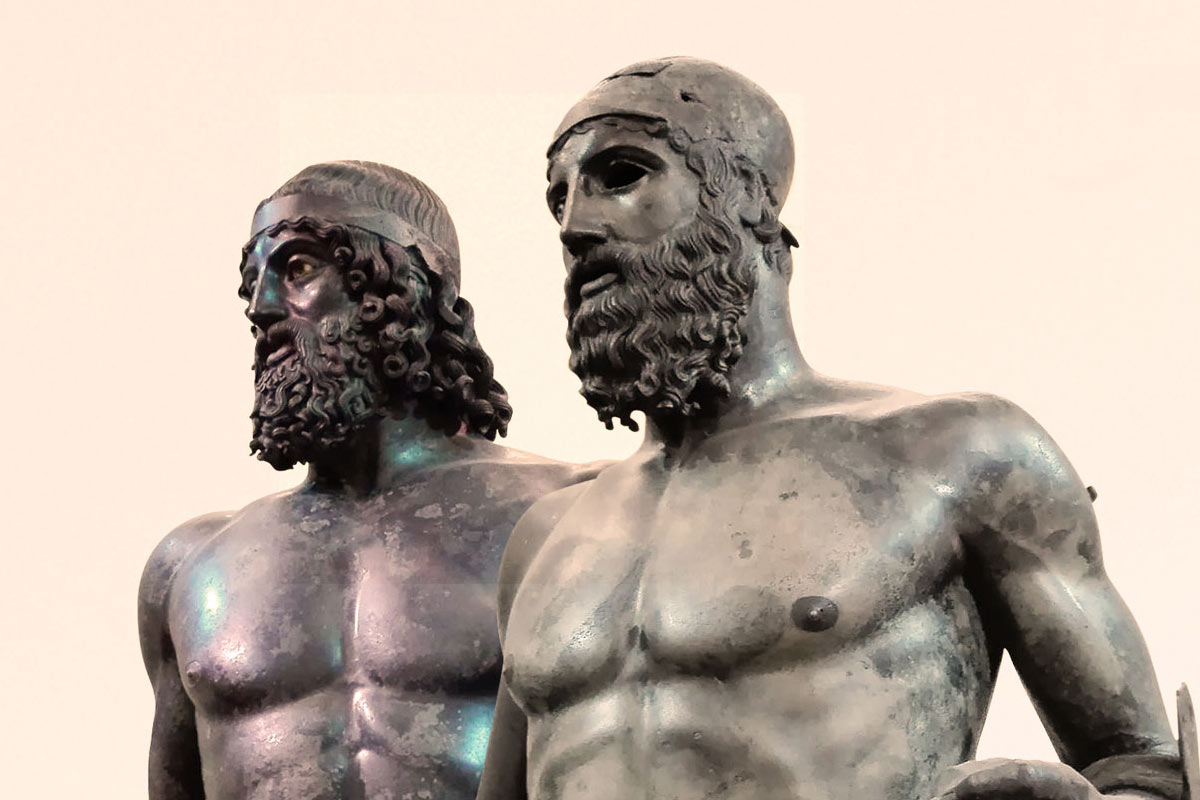In 1972, scuba diver Stefano Mariottini made a groundbreaking discovery along the coast of Riace, Calabria, Italy. Buried beneath the sand and sea, two extraordinary bronze statues lay dormant for over two millennia. Known today as the Riace Bronzes, these statues are hailed as masterpieces of ancient Greek art, embodying the technical prowess, artistic vision, and cultural significance of Greek civilization in the Classical period.
Discovery and Preservation: Bringing the Warriors to Light
The two statues, commonly referred to as Statue A and Statue B, were found submerged and hidden in the shallow waters off Riace’s coastline. Their preservation in seawater allowed them to escape the fate of most bronze sculptures of the time, which were often melted down for their valuable metal. The discovery of these nearly intact bronzes was remarkable, as ancient Greek bronzes are extremely rare; most artifacts that survive today are marble copies made by the Romans. Following their discovery, the statues were carefully transported to the Museo Nazionale della Magna Grecia in Reggio Calabria, where they underwent meticulous restoration and conservation efforts.

The Statues: Dimensions, Materials, and Details
Both statues, believed to represent ancient Greek warriors or heroes, stand over six feet tall, with Statue A measuring approximately 198 cm (78 inches). Their commanding presence is enhanced by the exquisite materials used. The artists employed lost-wax casting, a technique allowing them to capture fine anatomical detail, resulting in lifelike muscularity, expressive faces, and distinct postures.
Key details elevate their realism:
- Copper Lips and Nipples: These small copper accents give a warmer, lifelike hue to the bronzes.
- Silver Teeth: Delicate silver teeth are visible in the open mouth of one of the statues, suggesting a dedication to detail.
- Eyes Made from Calcite: Calcite eyes, with inlaid irises, bring an intense and focused expression, contributing to the statues’ imposing aura.
Artistic and Historical Analysis: Who Were These Warriors?
Experts suggest the Riace Bronzes date back to around 460-450 BC, placing them in the Classical period, a peak era for Greek sculptural art. Their exact identity remains a mystery, but prevailing theories propose they might represent warriors or mythological heroes. Some researchers speculate that the statues could depict characters from a famous Greek epic or figures such as Castor and Pollux, the twin gods of war. Others suggest they may represent hoplites (Greek soldiers), which could explain their original equipment of a spear and shield, both now missing. It’s also thought that one of the figures might have once worn a wreath, perhaps marking him as a victor or an esteemed figure in Greek mythology.

The Lost-Wax Casting Technique: Greek Engineering and Artistry
The Riace Bronzes exemplify the ancient Greek lost-wax casting method, a technique of complex artistry that allowed for intricate surface detailing. This process involved creating a wax model, covering it in clay, and then heating it to melt the wax, which was then replaced with molten bronze. The result was a hollow statue, strong yet delicate, perfect for capturing the human form with lifelike accuracy.
This technique was instrumental in achieving the warriors’ idealized yet realistic physiques, embodying the Classical Greek focus on human anatomy, strength, and grace. Their dynamic, relaxed postures reflect a Greek artistic trend called contrapposto, a stance where the weight shifts onto one leg, creating a sense of movement and realism that was innovative for its time.
The Riace Bronzes’ Cultural and Artistic Legacy
The Riace Bronzes not only celebrate Greek sculptural skill but also embody the cultural values of the time. Ancient Greece placed immense significance on the human form, particularly in physical ideals of beauty, strength, and divine favor. Sculptures like the Riace warriors were not merely artistic creations; they were ideological symbols, promoting Greek concepts of heroism, honor, and excellence (arete).
Since their unveiling to the public, the Riace Bronzes have captivated audiences worldwide, serving as both cultural icons and invaluable educational tools. Scholars and art lovers alike are drawn to these statues, intrigued by their mystery, struck by their realism, and inspired by their connection to an era that profoundly shaped Western civilization.
Legacy and Modern Influence
Today, the Riace Bronzes continue to be celebrated as two of the finest examples of ancient Greek sculpture. Their exceptional detail and preserved state provide historians, archaeologists, and artists with rare insights into the cultural ideals, technological innovations, and artistic advancements of the Classical Greek period. Located at the Museo Nazionale della Magna Grecia in Reggio Calabria, they remain a symbol of Italian heritage and ancient artistry, standing as a timeless reminder of Greece’s enduring legacy and the unending fascination with the mysteries of antiquity.

